Town Forest Trail Conservation Area self guided natural history walk
Pat Rice: plant ecologist looking for an excuse to be outside
Spring is progressing -- The trees are leafing out and the shady forest have fewer flowers at ground level, but in sunny areas, some low growing herbaceous plants, shrubs and trees are flowering. Getting out and seeing the changes is fun! And trying to figure out which plants are which remains a challenge. I’ve put white flags near and tied orange flags to particular plants (or sometimes near them) with the names on them. Because the flags are picking up on time sensitive points such as flowers or early leaves I’ll leave the flags out for about 2 weeks, then remove them from any given trail. Please leave the flags there, I will pick them up (and reuse them). The trails and plants will still be there after the flags are removed (well, some of the invasives will get clipped). Mostly I will be noting seasonal changes of our native plants. But, I’ll also note some of the invasive plants with comments on their effects on the native plant communities.
Town Forest
Marked TOP Trail
flagging May 19 – June 1(ish) to the north and a short stub east to the stream
Off of River Road
as #3 Town Forest from the Picnic area in the Pepperell Trail Guide
To Town Picnic Area parking:
From Pepperell Town Hall, go East .4 miles on Main St. to the rotary. Bear right onto River Road (Rte. 111) South. At 2.2 miles turn right into the Picnic Area parking lot. The GPS coordinates for the Town Picnic Area are Latitude 42.64388; Longitude -71.59333.
https://nashobatrust.org/trail-guide.html
www.town.pepperell.ma.us/trails
General observations:
Please do not walk in the mud or wet areas, that creates a lot of disturbance.
Ticks: just be careful to check yourself after a walk. Spraying insecticide on your clothes can deter them, but check anyway.
Poison Ivy: The oils are present year around, don’t grab the branches, roots or stems. Wash with a good soap after exposure. Some trails can be a problem to walk where poison ivy has grown onto the trail surface. The main Town Forest Trail is ok, the access off of Elm St. would require care.
I put up the flagging from the picnic area, along the main trail to a fallen tree where I stopped flagging. The trail continues past the fallen tree if you can scramble over or around it, it will connect to the access to Elm St. (be careful of poison ivy in the trail), where public trails continue across Elm St to NCT’s Linkel Woods. Or you can continue North to the trails at the Keyes Farm property. There are different plants in different areas, look around as you go! The slope area about where the side trail goes to Elm St is particularly interesting because water seeps out of the ground there and supports plants that grow in wetlands and plants that need more sun.
Town Forest:
The Town Forest is town land that is occasionally logged for timber and much of the area has been managed to produce a forest dominated by white pine. The logged areas have a fairly open canopy that allows growth of sun loving species, especially ones that do well after a disturbance. There are many arching, prickly shrubs of the blackberry family that are about to flower, and after that, produce delicious fruits. I didn’t mark these plants, mostly because I don’t know what species they are– but I think species of both raspberries or blackberries are present, including large arching plants and low growing dewberries (a kind of blackberry). In the next few days/weeks they will produce abundant white flowers. When they are in fruit, it is fine to pick and enjoy them – blackberries produce so many fruits that they often become old on the vines, I don’t think there is a problem with competing with the wildlife, they’ll eat what they want of the wild blackberries and raspberries. There are also blueberries and huckleberries that will be there for enjoying the fruits in a month or so.
From the picnic area/parking area take the trail north.
1. Canada Mayflower is flowering now, we’ve seen the leaves just emerging in the early spring and in bud a few weeks ago. Now seeing the displays of small white flower clusters it is easy to see why it is sometimes called wild or false lily of the valley. They will produce small round fruits that will turn red by fall.
2. This area along the trail is regularly disturbed and plants that do well in disturbance are abundant. Glossy buckthorn with shiny leaves does well in sun and partial shade.
3. Poison ivy is both a shrub and a vine. The vine form here is growing on a bigtooth aspen sapling (the aspen leaves will lose their whitish hairs as they mature) Bigtooth aspen trees start in the sun, but can grow to be as tall as other forest species. The reddish poison ivy leaves will become greener as they develop over the summer, then in the fall they will turn a beautiful brighter red. They are native, and birds love their white fruits.
4. Crossing the powerline right of way, the trail continues to the north. Look for flags on the corner and along the trail. Throughout the powerline ROW and along the sunny parts of the path are low growing viny plants with yellow flowers and 5-parted leaves. I tagged these as cinqfoil. They are dwarf cinquefoil, native members of a confusing group of plants some of which are native and others are even weedier introduced non-natives.
5. A large flowering shrub at the edge forest is Morrow’s honeysuckle. These invasive plants are at their most attractive now, pretty white, fragrant flowers. Later its abundant red fruits that will be dispersed to disturbed areas and often produce dense patches.
6. Sweetfern is a fragrant plant if you rub the leaves. It is a woody flowering plant, not a fern at all, but the toothed leaves really do look fern-like. It often grows on poor soils where it has an advantage over many other plants because specialized bacteria in its roots fix nitrogen from the air and make it available for the sweetfern to grow.
7. Mixed with the sweetfern is another short shrub, winged sumac. Winged sumac’s compound leaves have broadened leaf material along the veins that connect the leaflets, making the leaves distinctive. Winged sumac will grow taller than the sweetfern and eventually form dense thickets.
8. Trembling aspen can grow to be a forest tree species, but it has to start in the sun. It is identifiable by its small, thin triangular leaves. Trembling aspen often sprout from underground stems or roots with the result that all the trees in an area may be a genetically single individual, connected underground.
9. Oriental bittersweet is an invasive woody vine that will grow up native trees and cover them with its own leaves, sometime shading them out. The woody bittersweet vine grows by winding around the supporting plant’s trunk, and may cause the tree trunk to girdle itself as it tries to grow sideways through the encircling vine.
10. Black- (or rasp-) berry plants are all around here. Armed (that is, covered with prickers), about to flower, and often forming impenetrable masses of vines in sunny areas. Many are able to produce roots if the arching vine touches the ground, making very dense clusters of vines.
11. This area has a mix of plants, huckleberries are related to blueberries, and produce sometimes yummy, sometimes cardboardy, fruits. The flowers are yellow-ish tubes, the leaves have resinous glands. The fruits are black and look like blueberries but have fewer, larger seeds.
12. Maleberry is another relative of blueberries with white bell-shaped flowers, but its fruits are dry brown capsules.
13. Maple-leaf viburnum is a low shrub that has clusters of white flowers, the buds are present (May 19), it should open soon. Black fruits are often present through the winter.
14. The trail goes over a culvert with wet areas on either side. There are clumps of sedges and several different ferns present (look to the right, east). (I see royal, sensitive, and cinnamon ferns. Also highbush blueberries.) to the left is a large willow shrub. Good native diversity!
15. Along the trail in the moist areas are at least 2 species of white violets and a purple violet. Lance -leaved violet is nice because the white flower occurs with long thin leaves that don’t look like other violets. The other white violet has a very small flower (for a violet), it is probably smooth white violet.
16. Also along the trail edge are lowbush blueberries, maple seedlings, and lots of maple seeds that have fallen from the surrounding red maple trees.
17. Bluets are growing in clumps along the trail edge. They grow wherever they can get to that has abundant sunshine. Look closely at the 4-petaled flowers, not really blue, but white with a yellow center. For a small plant, they become quite noticeable in their large groups.
18. A small black oak sapling is hosting some oak galls. Unless the tree becomes heavily infested, the galls are not thought to a problem. There are different kinds of galls. These “oak apple galls” are formed by the tree in response to a small wasp that puts out enzymes that highjack the tree’s growth controls. The wasp lays an egg and the tree is tricked into forming a protective gall around the developing larva. In the past oak apple galls were used as a source of tannic acid.
19. There are sheep laurel plants, the brown dried material is last year’s fruits. The small shrub will have purple flowers in June. It is in the same genus as mountain laurel, but not as large, and not quite as evergreen.
20. Bracken ferns are still unfurling their large 3-branched leaves. These ferns don’t grow in wetlands, but are often in dry acidic forests, under oaks and pines.
21. The forest here seems to be dominated by white pine and red maples, with other species including oaks, aspens, and sugar maple present.
This is as far as I put out flagging on the plants. As noted above the trail continues to the adjoining Keyes Farm conservation land. It’s a nice walk, with areas with quite different vegetation, some wetlands, slopes, and the nice stream crossing at the Keyes Farm red trail.
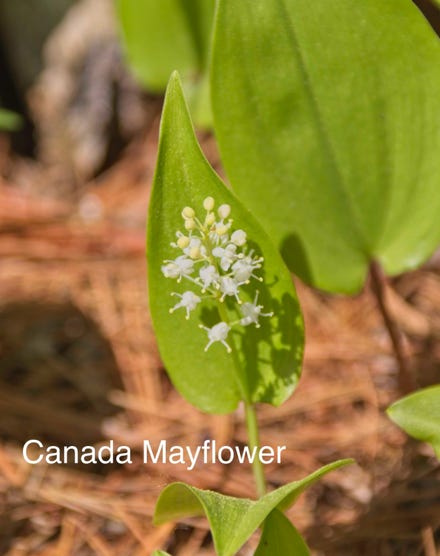
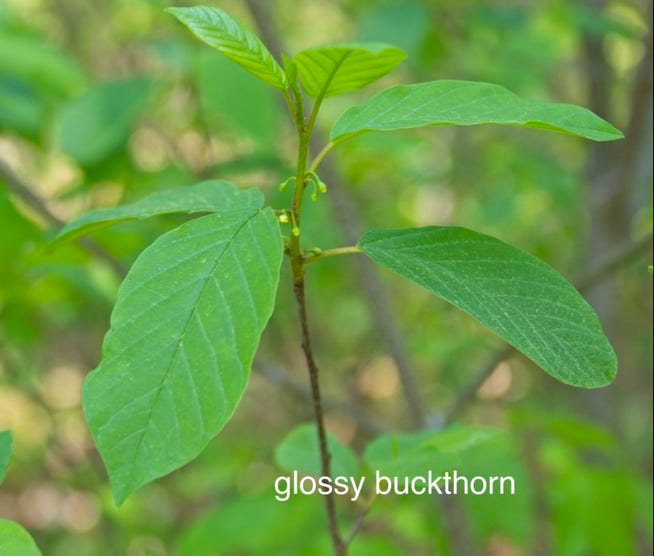
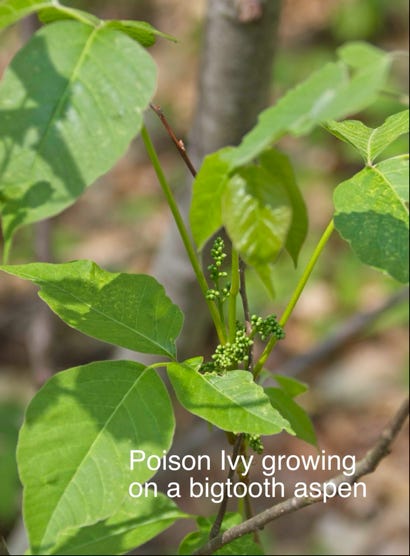
cinquefoil

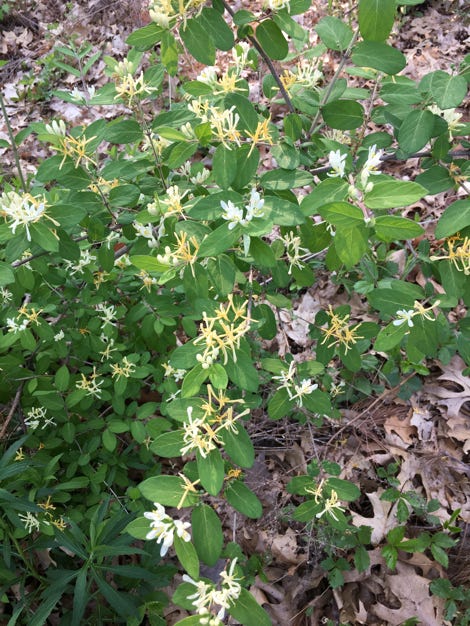
Morrow’s honeysuckle
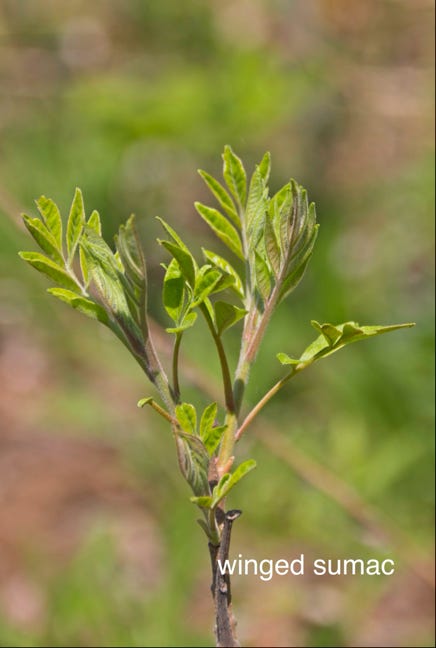
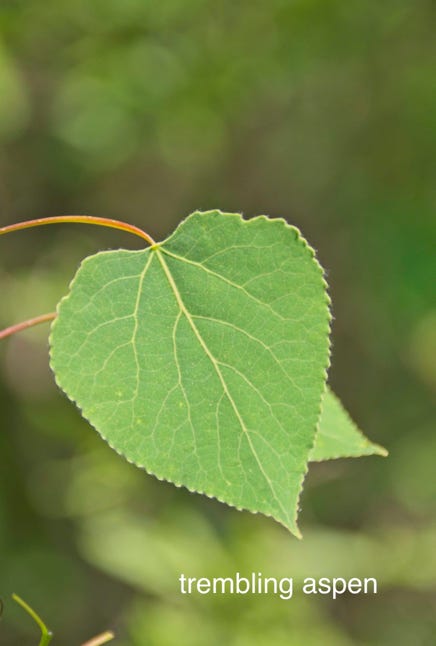

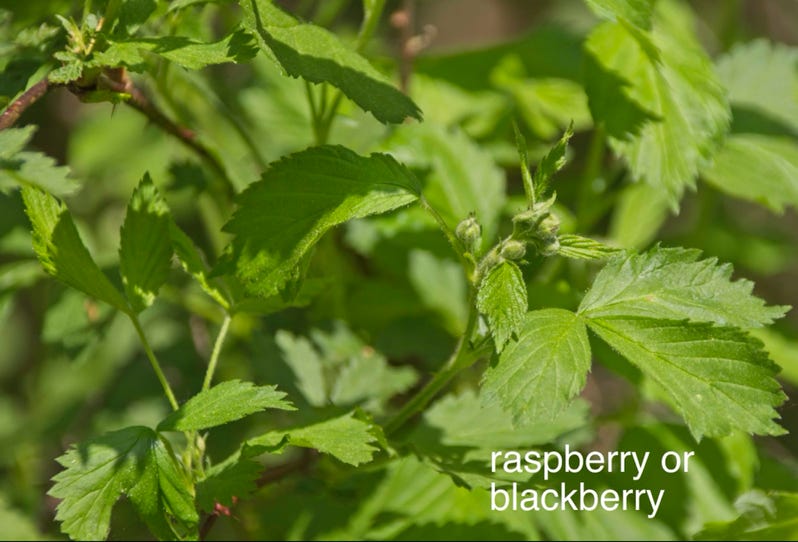
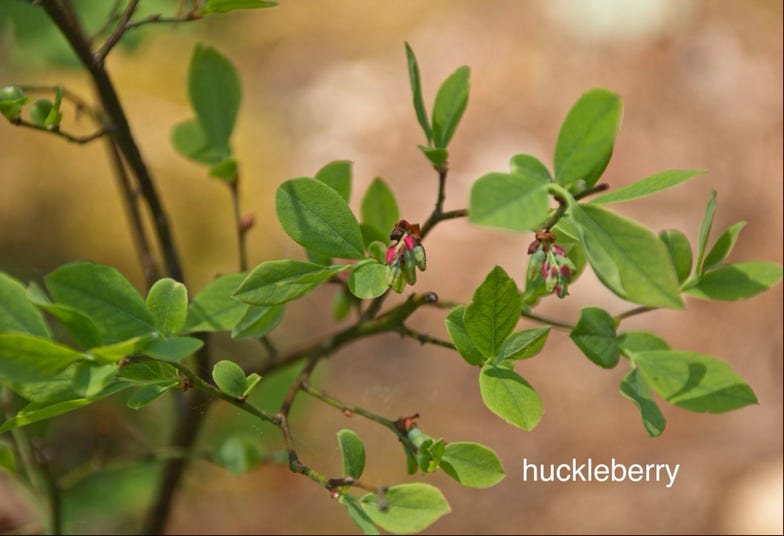
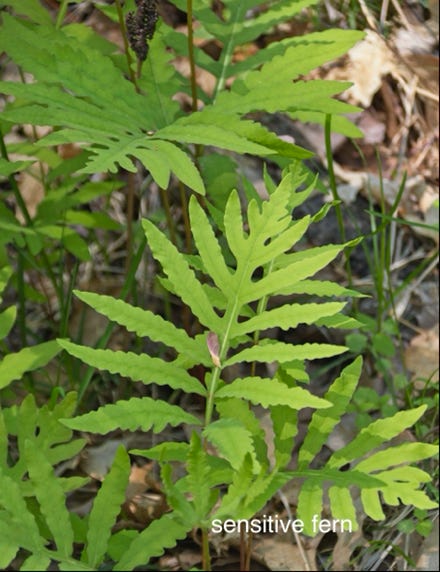
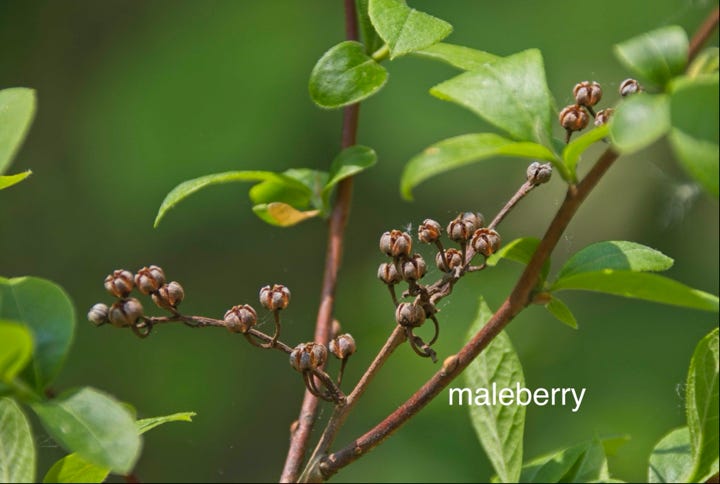
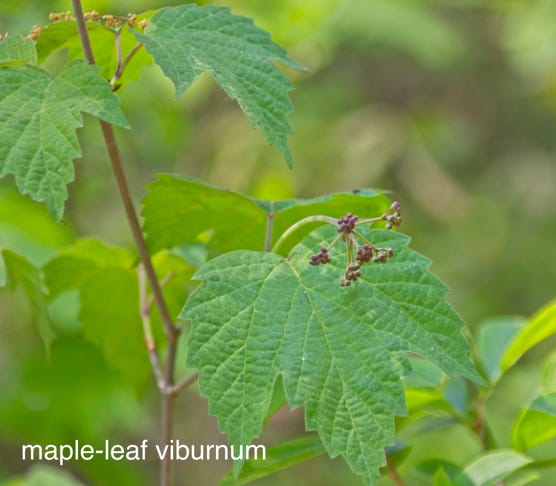
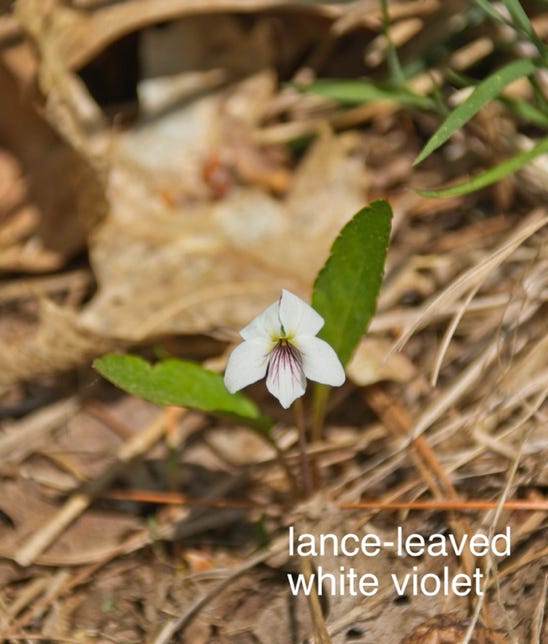
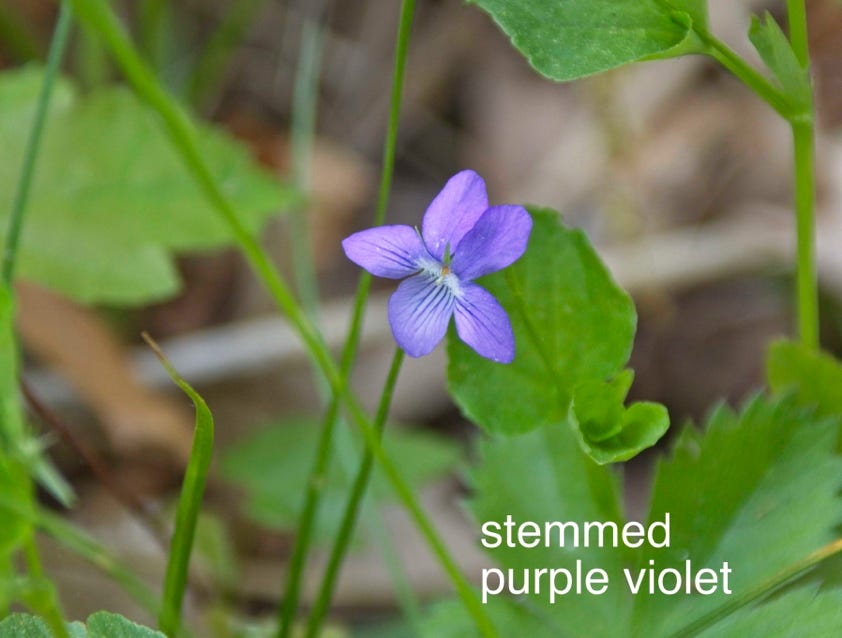
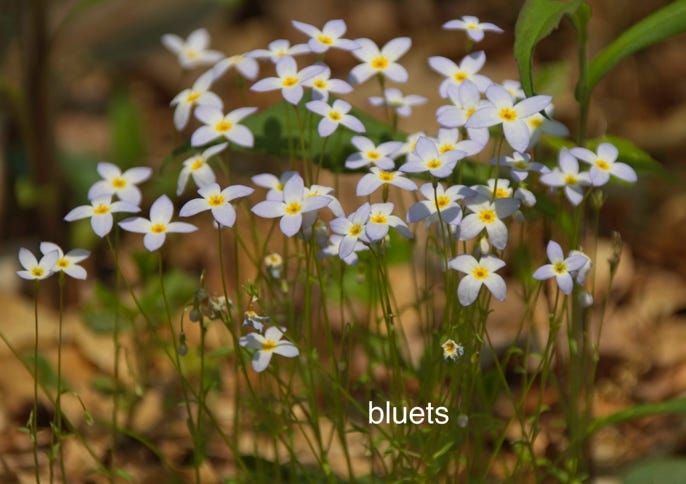
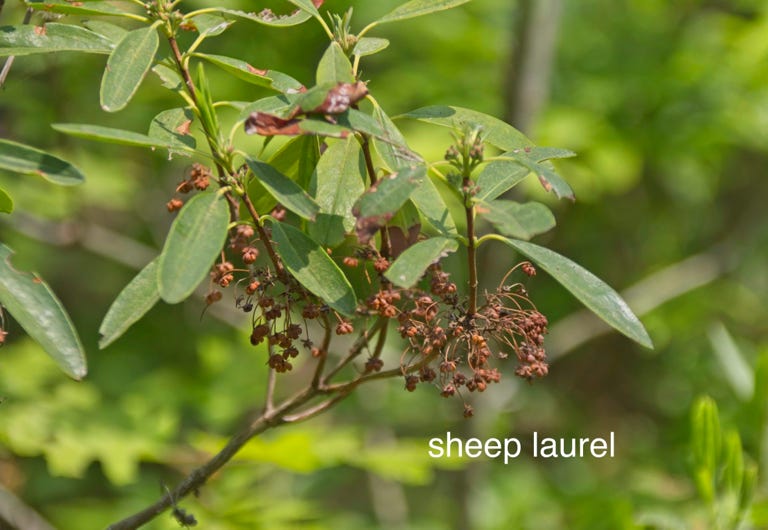
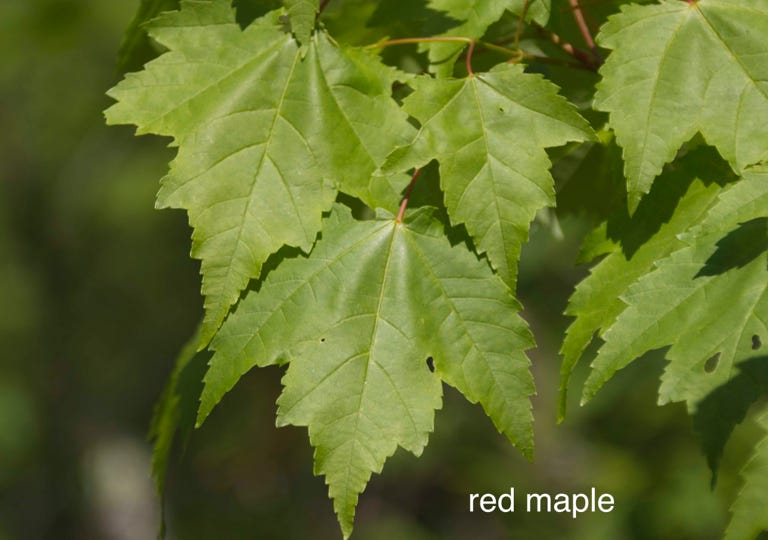

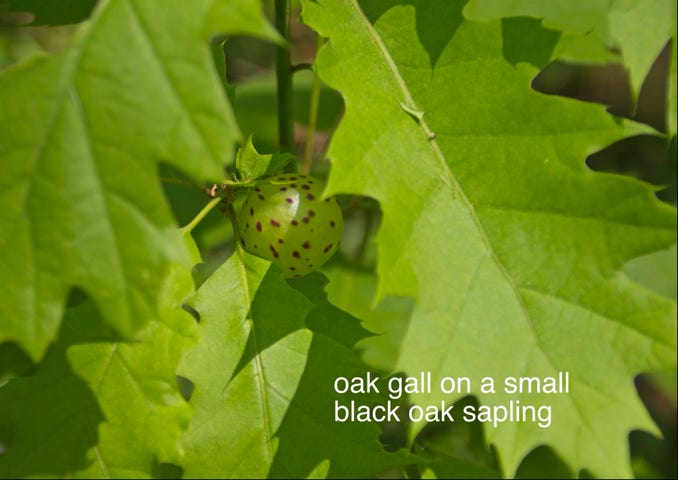
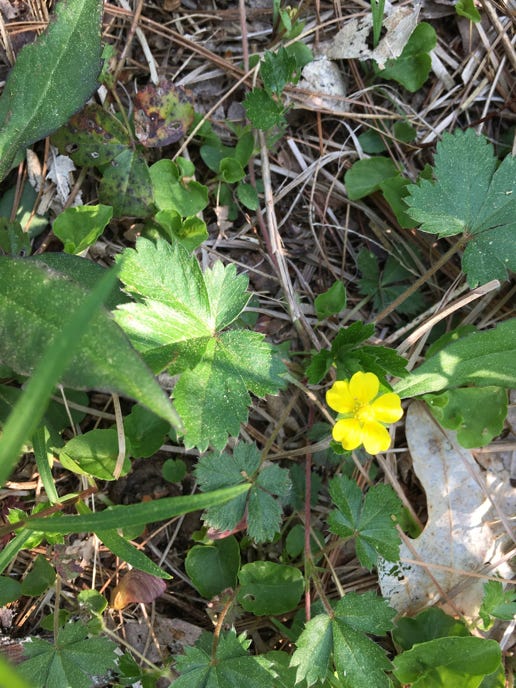
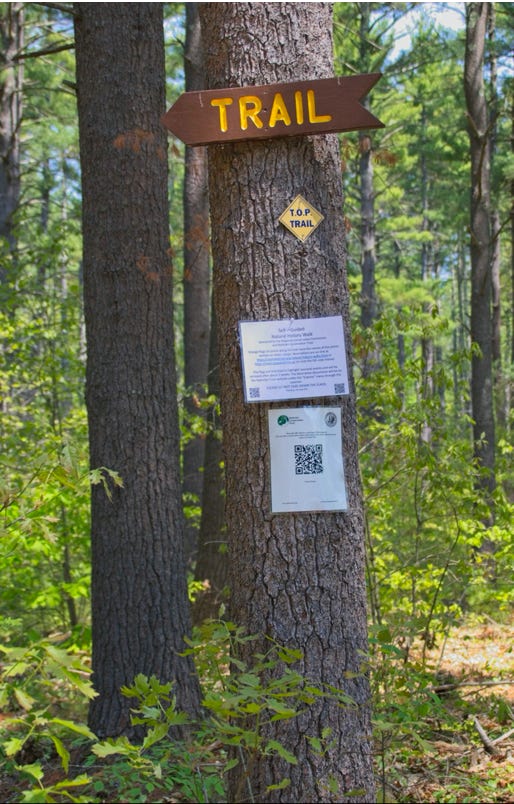

These self guided natural history walks are collaborative efforts.
Pat Rice identifies and flags all the points of interest. Sue Bleiweiss took the photos and is posting the descriptions on line for the Nashoba Conservation Trust. Paula Terrasi posts them for the Pepperell Conservation Commission.
All rights reserved. All content on this site property of Nashoba Conservation Trust.
Do not copy or reproduce in any form for any reason without written permission from Nashoba Conservation Trust.